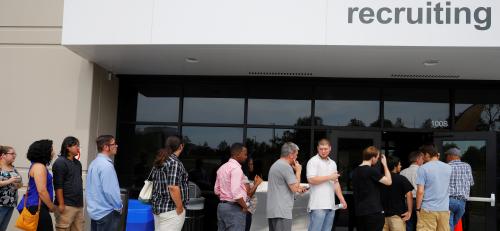A good job providing entry into the middle class increasingly requires a college education, but large numbers of young people in the United States may not reach this level of economic refuge. About 40 percent of all 18 to 24 year-olds are not in school and do not have a college degree, placing them at risk of unemployment or unsteady, low-wage work as they approach adulthood.
Understanding who makes up that 40 percent, and where they live, are important steps toward helping more young people connect to educational and economic opportunity.
Educational attainment — a sobering picture
Labor market sorting by education starts young. Nearly 80 percent of 23-24-year-olds with a Bachelor’s degree have a job, compared to 60 percent of those with a high school diploma or less. Recent labor market projections show that the importance of education in the labor market may only accelerate: jobs requiring a graduate degree are expected to grow twice as fast as those requiring only a high school diploma or less.
Among all young people in the U.S. ages 18 to 24, seven percent did not complete high school, 22 percent have a high school diploma but no other credential, and 11 percent have completed some college but did not earn a degree. This “some college” group is a mixed one; some of these young people are probably in good shape having completed occupational-related programs in fields such as IT, healthcare, and auto mechanics. On the other hand, the group also includes individuals who took one or more courses not necessarily focused on particular skills or industries, left school without a credential, and may have incurred student debt along the way. Unfortunately, evidence suggests that the majority of those with some college experience and no degree have not obtained an alternative credential such as an educational certificate, professional certification, or license.

Significant variation locally
Places with low levels of education are not well-positioned to compete in an economy shifting towards technology and professional services. As economist Enrico Moretti described, “A handful of cities with the ‘right’ industries and a solid base of human capital keep attracting good employers and offering high wages, while those at the other extreme, cities with the ‘wrong’ industries and a limited human capital base, are stuck with dead-end jobs and low average wages.” The educational attainment of local young people is thus an important indicator of how a city is positioned for future growth and prosperity.
In this respect, some places are on much more solid footing than others. Educational attainment among 18 to 24 year-olds varies widely at the local level, reflecting demographics, the strength of regional economies, and dominant sectors in those economies. Among large cities and counties, the share of young adults who are not in school and have no more than a high school diploma ranges from 40 percent and above (Detroit, Polk County, Fla., Phoenix, Kern County, Calif., and Clark County and Las Vegas in Nevada), to 10 percent and below (Boston and San Francisco). Employment in the tourism and agricultural industries (as in Las Vegas and Clark, Polk, and Kern counties) does not typically require high levels of education. The presence of relatively large Latino populations (Phoenix, Las Vegas, and Clark and Kern counties) also plays a role, since Latinos overall—and young Latino immigrants in particular—have lower educational levels than other groups. Boston and San Francisco, meanwhile, are technology hubs that attract and draw from well-educated labor pools.

Thus, we face two major, inter-related challenges: 1) Too many young people face bleak employment prospects based on their educational levels and skills; and 2) These young people are concentrated in regions that are themselves struggling economically—part of the nation’s economic divergence in which a fortunate few metro superstars dramatically outpace the others on wages, job growth, and productivity.
Workforce development, meet regional economic development
It is not an original idea that an educated workforce supports economic growth. Historically, however, economic development has sought to attract workers from other regions more than supporting efforts to develop homegrown talent.
The country is doing itself no favors by consigning millions of young people to the margins of the labor market and economic mainstream
Our Metro colleagues have argued that should change, and that business leaders and economic development groups should invest in and cultivate long-term economic assets—including the skills of local residents—in order to promote more inclusive growth and create better outcomes for people, firms, and communities. Meanwhile, some of the most successful workforce development strategies are the result of close collaboration between educators, community groups, and employers.
To increase economic opportunity for young people and prepare the future labor force, we should adhere to the following principles, and support active partnerships across sectors (education, business, community groups, government) to make it happen:
- Continue to increase access to post-secondary school or training, but set our goals around completion. Enrollment is only a first step; too many students leave without earning certificates or degrees.
- Recognize that a Bachelor’s degree is not the only game in town. A four-year investment in time and money is not feasible or desirable for all, but apprenticeships, associate degrees, and short-term training programs represent real learning experiences and can generate significant payoffs in the labor market.
- Hire based on skills rather than degrees, which are not always an accurate measure of what a person knows and can do. Evaluate the skills required for particular job openings, and assess job seekers accordingly in order to find the right match. This creates a hiring pool more attuned to employer needs, and opens up positions to a wider range of job seekers previously locked out by an AA or BA requirement.
- Lastly, employers should not be passive recipients of talent. Through active partnerships with educators and training organizations—for example, providing input on curriculum and offering internships—employers can strengthen the talent pool from which they draw and help their own bottom line.
The above ideas point to solutions that are entirely within the realm of the possibility, and in fact, they are already being implemented—but at nowhere near the scale required. The country is doing itself no favors by consigning millions of young people to the margins of the labor market and economic mainstream, even as many employers say they can’t find the workers they need. In forthcoming research, we will look more closely at 18-to-24-year-olds who are out of work and identify local strategies to help young adults increase their skills and find pathways into the work world. We need to think and act more boldly if we want to ensure that economic growth and prosperity are shared more widely across both people and places.
The authors thank Natalie Holmes for much of the data analysis supporting this post.
Note: An earlier error in the percentages under the “Attending School” category on “The Education Pipeline” graphic above has now been corrected.








Commentary
On their way? A portrait of young adults
December 1, 2017